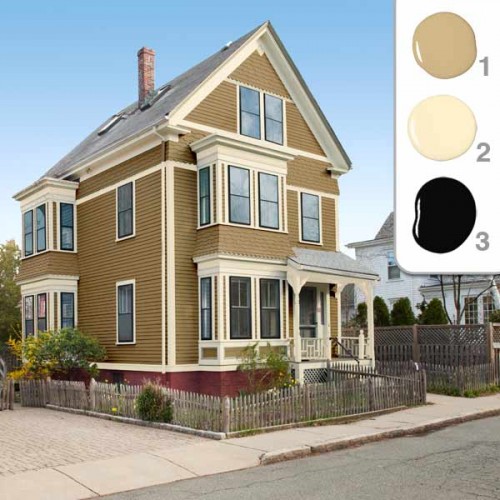How to find the best color combinations for your exterior painting project
If you're planning to paint an older home, you'll probably want to use a historically accurate color scheme. You can hire a pro to analyze old paint chips and recreate the original color. Or, you can refer to a historic color chart and select shades that might have been used at the time your home was built.
Paint Color Idea: Historic Colors at Roseland Cottage
2. Jazz Up the Past
In some neighborhoods, homeowners fly in the face of history. Instead of choosing historically accurate colors, they paint their houses modern colors to dramatize architectural details. Using bright colors on old architectural details can produce startling and exciting results. But before you buy 10 gallons of bubblegum pink, it's a good idea to look at what your neighbors are doing. A fluorescent colored Victorian that looks splendid in San Francisco will seem wildly out of place in more conservative neighborhoods.
Paint Color Idea: Green and Pink Antique Shop in St. Augustine, Florida
3. Consider Your Neighbors
The house next door can give you paint color ideas, but don't copy your neighbor exactly. Choose colors that set your house apart, without clashing with nearby buildings.
Paint Color Idea: Colorful Cottages
4. Borrow From Nature
The landscape around your house is blooming with color ideas. Trees may suggest an earthy palette of greens and browns. A beach setting might suggest vivid blues, turquoises, and coral colors. Even the garden in your front yard can inspire exciting color combinations.
Paint Color Idea: Garden Colors of Yellows and Blues
5. Check the Roof
Your house is your canvas, but it is not blank. Some colors are already established. What color is your roof? Slate? Terra cotta? Metal? Clay? Your paint color doesn't need to match the roof, but it should harmonize.
Paint Color Idea: Seafoam Green Victorian Cottage
6. Look For Things That Won't Be Painted
Every home has some features that will not be painted. Does your house have brick walls? Vinyl windows? A natural wooden door? Will steps and railings remain their existing colors? Choose a color scheme that harmonizes with colors already present on your house.
Paint Color Idea: Brick and Stone on a Queen Anne
7. Find Inspiration in Your Living Room
It may seem comical to paint entire house based on the pattern of a pillow case, but this approach does make sense. The color of your furnishings will guide you in the selection of your interior paint colors, and your interior paint colors will influence the colors you use outside. Once again, your goal is to harmonize.
Paint Color Idea: Frank Lloyd Wright's Red
8. Focus on Details
Depending on the size and complexity of your home, you may want to choose two, three, or as many as six colors. In addition to color for your siding, select accent colors for shutters, moldings, doors, window sashes, brackets, columns, and porch decks. But beware: too many colors will overwhelm your house. Too few can make your house seem flat and uninteresting.
Paint Color Idea: Four Colors Chosen for a Florida House
9. Use Light to Add Size
It's no wonder large, grand estates are often painted white. Light colors make a building look larger, and white is the favored color for traditional classical architecture. In fact, there's a very famous White House in Washington, DC! You can add to your home's sense of size and dignity by using white or a pale cream color.
Paint Color Idea: Classic White of Hill-Stead in Farmington, Connecticut
10. Go Dark For Drama
Dark siding or dark bands of trim will make your house seem smaller, but will draw more attention to details. This technique of accented banding can be found in many of Frank Lloyd Wright's interiors. For exteriors, accent recesses with darker shades and highlight details with lighter tones. Traditionally, the window sashes of Victorian homes are painted with the darkest of the chosen historic color combination.
Paint Color Idea: Dramatic Dark Red Trim Accents a Harvest Gold Home
11. Discover Color Families
Contrasting colors will draw attention to architectural details. But, extreme contrasts will clash and actually detract from details. To be safe, consider staying within a single color family. For some accents, try using a darker or lighter shade instead of a different color.
Paint Color Idea: The Harriet Beecher Stowe House in Hartford, Connecticut
12. Strike a Balance
A burst of a single color on just one part of your home may give it a lopsided appearance. Strive to balance colors over the entire building.
Paint Color Idea: Balanced Colors on a Los Angeles Cottage
Montes Painting 2014
http://architecture.about.com/cs/repairremodel/a/pickcolors.htm


No comments:
Post a Comment